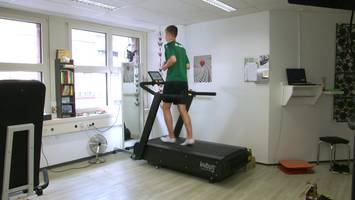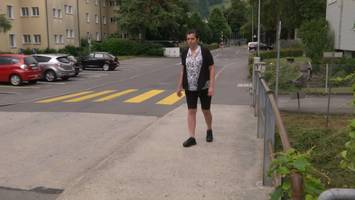MS (multiple sclerosis)
Even though this disease is not curable, its course can often be influenced positively by various measures. Contrary to popular opinion, multiple sclerosis does not necessarily result in severe disabilities. Most patients are still able to walk many years after the onset of the disease.
The kybun shoe/kybun mat provides coordinative training for the musculature and improves mobility. This results in better stability and balance so you feel more confident while standing and walking. With kybun you can independently provide gentle training and therapy for your body day after day.
Definition
Multiple sclerosis (MS), also called encephalomyelitis disseminata (ED), is a chronic inflammatory disease of the central nervous system (CNS) in which the insulating covers of nerve cells are damaged. Despite extensive research the cause is not known. Next to epilepsy, it is one of the most common neurological illnesses among young adults and is of significant importance in social medicine.
With multiple sclerosis, multiple scattered lesions develop in the white matter of the brain and spinal cord. These are presumably caused by the attack of the body’s own antibodies on the myelin sheaths of the nerve cell extensions. Since the lesions can occur anywhere in the CNS, multiple sclerosis can cause almost any neurological symptom. Vision disturbances with a reduction in visual acuity and eye movement disturbances (internuclear ophthalmoplegia) are typical but not specific to multiple sclerosis. The severity of the patient’s disabilities is often specified using a scale (EDSS).
Causes
In spite of extensive research, the cause has not been established.
Numerous theories exist with regard to the pathogenesis (emergence) of the disease. Existing findings indicate multifactorial pathogenesis with the involvement of genetic factors and environmental influences as triggers of immune-mediated damage.
Long-term consequences
Every affected individual has different symptoms of varying severity (vision disturbances, paraesthesia, signs of paralysis etc.).
When the overall course of the disease is examined, the symptoms that most often impair the quality of life for affected individuals are fatigue, bladder function disturbances and disturbances of the motor system, such as paralysis and spastic hypertonicity.
Conventional therapy
The kybun principle of operation – being proactive
The feet can move freely in all directions in the kybun shoe/on the kybun mat and you can feel the ground with the feet through the soft, elastic material, similar to walking barefoot on soft, natural soil. This improves foot mobility and sensitivity, which in turn leads to better balance.
Initial reactions
Specific initial reactions with MS:
You may initially feel too unstable in the kybun shoe. Give yourself some time. Your body first has to get used to the new kybun walking, especially if you have been wearing stabilising shoes until now. If this occurs, follow the tips under ‘Application tips’.
Click here for the general initial reactions experienced by kybun mat and kybun shoe beginners: Initial reactions
kybun exercises
Application tips
- Since MS has many different stages, it is never possible to make statements about individual effectiveness without trying kybun for yourself. It is important for the affected individual to feel comfortable and not overtaxed by kybun training. That means not overdoing the training (adjust the duration of use!). Most people are able to assess this adequately for themselves.
- Try various kybun shoes; some models with a higher cut provide more stability. We also recommend a kybun shoe model with a lower rebound effect. It is a bit wider in the midfoot area, therefore making you feel more stable while walking.
- If you still feel too unsafe walking in the kybun shoe, we advise using the kybun mat. The kybun mat is available in three different thicknesses. This allows you to choose the thickness that is most comfortable for you (the thicker, the more unstable, the more intensive the training).
You can also hold on to a fixed object if you need additional support when using the kybun mat. - Keep performing the kybun exercises regularly. This loosens your muscle tissue while intensifying training at the same time.
- Be sure to maintain an upright posture and do not look at the floor.
- Avoid taking excessively long steps since this makes it easier to balance your body weight on the soft, elastic material.
Opinions/customer testimonials
It was an experiment and we had no scientific proof that it would work. We were surprised to discover that it could improve neurological movement disorders, including MS and Parkinson’s disease. Of course, we also have patients with paralysis caused by a stroke, for example. We let them walk on the soft, springy kybun mat. We saw a clinical improvement in the situation. For example, this means that all of a sudden, patients with Parkinson’s disease require less medication or even none at all. They also no longer experience tremors. We’ve also noticed an improvement in MS patients, but we have definitely seen the greatest improvement in patients with Parkinson’s disease. However, mobility has also improved for patients with paralysis. It is actually a mystery to us how these improvements came about. We just don’t know. We can only assume that the stimulation caused by spatial awareness and in the lower extremities stimulates brain tissue. Certain interactions that were disconnected are suddenly open again. This is typical in Parkinson’s disease. We are continuing our research in this area in order to be able to confirm this with other patients with Parkinson’s disease. We were very surprised that it has an effect and of course, we’re delighted that it’s possible to help these patients.








